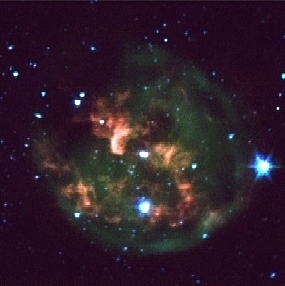
 A Planetary Nebula. Planetary nebula NGC 246 vision has been enhanced thanks to NASA Spitzer Space Telescope and its dust-piercing infrared capacity. Spitzer Telescope discovered that a giant ring was lying inside the gas envelope. Planetary nebulae are the way usual stars are dying. After having exhausted their hydrogen, they burn helium and when they stop burning helium they core shrinks and heats, boiling up and expelling the outer layers under the form of an hydrogen envelope. Remaining star is becoming a white dwarf, radiating ultraviolet photons into the nebula. Such a fate is the fate of about 99 percent of stars. Our Sun will end up like that. The remaining star seen here is the most feeble star just center of the nebula as the hydrogen envelope is mostly seen at its outermost boundaries. The ring specific to NGC 246 is seen slightly off-center of the white dwarf, as a dense, clumpy ensemble. Planetary nebulae formation is still ill-known as they are part of the recycling process by which matter is used to form new generations of stars. NGC 246 may be observed in the constellation of the Whale. It's a 11.8 magnitude object. Another typical exemple of planetary nebula is the famous planetary nebula of the Lyre (M 57). picture courtesy NASA/JPL-Caltech
A Planetary Nebula. Planetary nebula NGC 246 vision has been enhanced thanks to NASA Spitzer Space Telescope and its dust-piercing infrared capacity. Spitzer Telescope discovered that a giant ring was lying inside the gas envelope. Planetary nebulae are the way usual stars are dying. After having exhausted their hydrogen, they burn helium and when they stop burning helium they core shrinks and heats, boiling up and expelling the outer layers under the form of an hydrogen envelope. Remaining star is becoming a white dwarf, radiating ultraviolet photons into the nebula. Such a fate is the fate of about 99 percent of stars. Our Sun will end up like that. The remaining star seen here is the most feeble star just center of the nebula as the hydrogen envelope is mostly seen at its outermost boundaries. The ring specific to NGC 246 is seen slightly off-center of the white dwarf, as a dense, clumpy ensemble. Planetary nebulae formation is still ill-known as they are part of the recycling process by which matter is used to form new generations of stars. NGC 246 may be observed in the constellation of the Whale. It's a 11.8 magnitude object. Another typical exemple of planetary nebula is the famous planetary nebula of the Lyre (M 57). picture courtesy NASA/JPL-Caltech
Website Manager: G. Guichard, site 'Amateur Astronomy,' http://stars5.6te.net. Page Editor: G. Guichard. last edited: 12/28/2010. contact us at ggwebsites@outlook.com

